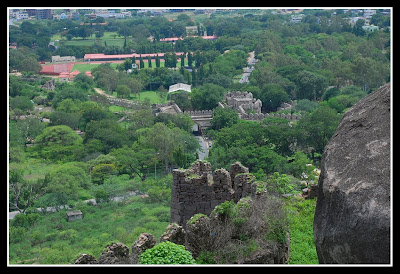"The Lost City" as its been called was unknown under sea, which only got revealed when Tsunami unearthed the surroundings, the city called Mahabalipuram
Its 52km from Chennai and we started off on 9/21/2009 from West Tamberam (Hired Taxi for 100Km 10hr@ Rs 1310). Its an little above an hour journey and one can see plenty of upcoming resort construction just near the sea shore. There is Rs 25 as panchayat fee when you enter the temple area, plus 10 for parking and finally Rs 10 for temple entrance which can be reused to visit other temples in that area.
 The temple (normally called shore temple) area is well maintained and is fenced surroundings. Its just few meters from sea shore and adjacent to the temple is local sea shops as it used to be in sea shore. Stones can be seen as melted by sea water and inside view of the temple is not open for public, the back side of temple has one room where one can see a big broken "Shiv Lingam". One side of the temple has this lion stone with a hallow gap in the chest, inside the hallow is another sculpture of some gods. The temple is surrounded by a stone wall on which a stone carved in "Cow" shape is placed.
The temple (normally called shore temple) area is well maintained and is fenced surroundings. Its just few meters from sea shore and adjacent to the temple is local sea shops as it used to be in sea shore. Stones can be seen as melted by sea water and inside view of the temple is not open for public, the back side of temple has one room where one can see a big broken "Shiv Lingam". One side of the temple has this lion stone with a hallow gap in the chest, inside the hallow is another sculpture of some gods. The temple is surrounded by a stone wall on which a stone carved in "Cow" shape is placed.Just a km from this temple is another area to visit "Panch Rathas" (Fine Carrots), you can use the same ticket which you have purchased for shore temple. These are said to be five Rath (Carrots) of Pandava's. All these five Ratha's are carved out of single stone and are named after five Pandava's. Pic on the left side shows the entrance of this area, four individual stones are visible and the one is on the back side counting to five Rath's.
 The first Rath is named after Draupadi, next to it is Arjun's, in front of it is Nakul-Sahdev's Rath The longest and the biggest one is of Bhima's Rath (see pic on right) which is said to be still incomplete. And the last tall one is of the Udhistar's Rath (bottom).
The first Rath is named after Draupadi, next to it is Arjun's, in front of it is Nakul-Sahdev's Rath The longest and the biggest one is of Bhima's Rath (see pic on right) which is said to be still incomplete. And the last tall one is of the Udhistar's Rath (bottom).There are plenty of things to explore here other then what mentioned in this blog.
For more information of this place, visit http://www.mahabalipuram.co.in



































